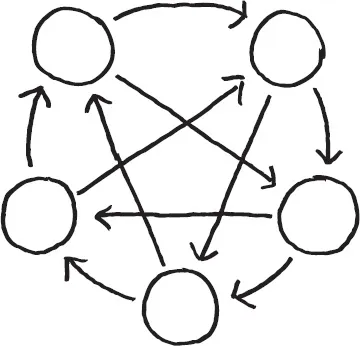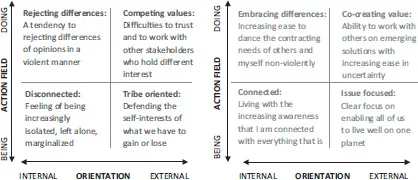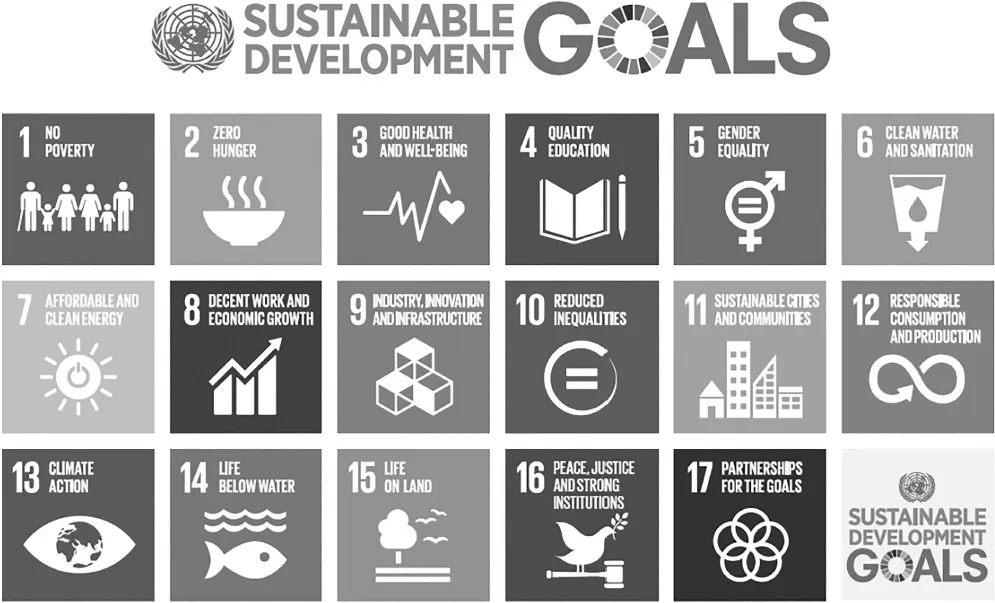![]()
Part I
The dynamics of change
Achieving change is complex in a world where society impacts business, business impacts society, and business and people impact and influence each other. In these times of rapid change and increasing complexity among inter-connected issues, business is challenged to become better in managing beyond its boundaries.
Chapter 1 highlights the disruptive effect of society on business and vice versa, and the connection between an individual and an organization. These interconnections are explored using the circle model, which connects the inner world with the outer world. It opens the space of emerging transformation that occurs when personal, organizational, and societal development coincide in a multi-stakeholder co-creation (or Collaboratory) process. These three dimensions of the I, We, and All-of-us provide the foundation of multi-stakeholder collaboration.
Chapter 2 demonstrates how these three dimensions play in multi-stakeholder collaborations, and how they enable the shift from a state of competition to a state of collaboration. These two states are explored in-depth and serve to frame the challenges of making stakeholder processes successful. Key insights from fellow facilitators introduce first ideas to understand these challenges by integrating competing strength polarities at the level of the individual, the group, and the shared issue.
If there was one image that could summarize Part I, it would be Figure I.1 that illustrates both states that exist when different parties work together: that of competition and that of co-creation. It shows that the journey from one to the other is about dealing with differences differently. That values can connect rather than divide and that listening to what is going on inside is an important anchor and resource for co-creation, possibly allowing that difficult shift to put an issue ahead of one’s “tribe.” In a time where business impacts people, and people impact business, where the next scandal is only an effective social media campaign away and where transparency is no longer a luxury but a pre-condition, the demands on the individual, each of us, are tremendous. We can no longer afford to be switched off or distracted while auto-piloting through life. Every day offers multiple challenge that will define how we are perceived by others, be it a casual bystander or an important business partner. The journey of personal development toward becoming increasingly responsible in the way we lead our life is directly coupled with the journey of organizational development that demands a net positive contribution to society and the world. As individuals, we are familiar with these inner and outer worlds and we all navigate them more or less attentively. We have found that co-creation projects with other stakeholders are outstanding moments in time where we can bring in both the best of ourselves as well as the best our organizations have to offer, and this alignment toward a higher goal has transformative powers that will continue to change the world. And this is, after all, what this book is dedicated to.
Figure I.1 The transition from a state of competition (left) to a state of co-creation (right)
![]()
Chapter 1
The interconnection of society, organizations, and individuals
Society has an impact on business and the SDGs frame these challenges as opportunities
The head of one of the oldest Swiss banks sits a last time behind his large oak wooden desk. His hands caress the smooth surface and he takes a deep long breath. Never in a million years would he have imagined that the Geneva-based investment bank that his grandfather founded would be shut down. Thinking of his grandfather made him sit up straighter. He would turn in his grave if he were to live this day.
It is not as if they had done anything wrong. The bank was known for treating its employees very well, providing generous Christmas baskets to all families, offering a generous vacation and pension plan, and in the past decade, they even opened their very own childcare center for their staff. Their inside fitness club with the Olympic pool was the envy of the industry and a rooftop cocktail bar notorious on Friday nights. They had more talent wanting to work for them than they could employ.
Their business has – like many other Swiss banks – consisted of safeguarding the wealth of important people around the world. Kings, princes, heads of state, politicians, and of course the occasional celebrity in film or sport. They carried these secrets with pride and with a barely noticeable smile. There was nothing more honorable than maintaining this secrecy and the banking sector has made Switzerland world-famous for this art. Until the turn of the century, that is. It all started in 2008, when Hervé Falciani, a systems engineer at HSBC, leaked more than 130,000 suspected tax evaders to the ex-French Minister Christine Lagarde. He was indicted in absentia in 2014 by the Swiss government for violating the country’s bank secrecy laws, but the eggs were long spilled.
In the course of the past decade, the unthinkable has become acceptable. The Swiss reputation as a trustworthy partner and the ability to hold a secret is tarnished and the bank secrecy is viewed as a haven of illicit money. The public perception has simply flipped and the US persecution of numerous Swiss banks has cost them billions of Swiss Francs in penalties for having helped tax evasion internationally. In late 2016, the Swiss Government has formally signed a series of agreements that represent the end of Swiss bank secrecy step by step in 2017 and 2018. Signing these agreements was important for the integrity and weakened reputation of Switzerland’s financial center. A change of perspective of such radical nature that as little as 10 years prior, nobody could have anticipated.
As the seasoned Swiss banker rises from his desk, grabbing his 30-year-old brown leather briefcase, he takes a last look across the river through the bay windows of his office. He was glad to be close enough to retirement not to have to worry about what this change would mean for his career. He was equally disturbed that his son was insisting on a banking career, how could there be any banking in a time where split-second trade gains were the only hope for a halfway decent income?
The end of the Swiss banking secret is one of a number of disruptive changes business is facing because of changing public perception and international pressure on local practices. The example is telling as it concerns questionable practices of a respected highly developed country, not an emerging country with practices that may not yet be up to the scrutiny of international standards. The emission scandal of German carmakers tells a similar story. Common and seemingly shared practices in a developed country suddenly face international scrutiny and crumble in the light of investigation. Companies take heavy financial and reputational hits and struggle to understand how this could have possibly happened. The public perception of what is ethical and what not, changes faster than companies can anticipate. Helped by social media, society has become a disruptive force for business.
These disruptions may be seen as risks or as opportunities – depending on your business model. Here things get interesting. How could you position your organization so that you can benefit from the changing perception, the burning issues in society, and what new business opportunities emerge for you from this? We are now in the SDGs era. A time marked by the significant achievement that happened in September 2015, where 193 countries agreed that the Sustainable Developments Goals (the SDGs) define the global agenda for the coming 15 years. The 17 underlying goals are also referred to as the Agenda 2030 (see Figure 1.1). They set the frame for multi-stakeholder engagement of our times. As Paul Polman has said so well, these challenges are too big and too complex to be solved by a single institution, government, or company. Only together do we stand a chance of dealing with these issues.
Figure 1.1 The 17 Sustainable Development Goals defining the global agenda until 2030
Business has the choice to take a proactive approach toward these global challenges. Many organizations such as the World Economic Forum (WEF), the United Nations Global Compact (UNGC), or the World Business Council for Sustainable Development (WBCSD) have suggested that these global challenges are truly hidden business opportunities, which are estimated to represent billion dollars of new revenues for business. Figuring out how to adapt current strategy processes to embrace such opportunities is a major challenge for business. Chapter 9 offers a concrete answer to this challenging question, introducing both tools and processes for business to embrace these opportunities. This book focuses on helping change makers in organizations and independent of organizations design a journey for achieving these opportunities.
Business has an impact on society
We have also seen how business has impacted society. There is increasing awareness of what it means for society when business disregards its externalities – the cost that do not bear a price tag but may represent a cost to the environment or to society. Take the unaccounted-for cost of forestry activities in terms of soil degradation, biodiversity loss, forced displacement of native tribes, or dried up rivers creating water security issues. Consider the impact of the fast fashion trend with its human rights issues along the supply chain. The mountains of discarded clothes from the developed world that bury developing countries such as Haiti or Ghana. The unprecedented amount of micro-fiber particles in rivers and oceans because of washing cheap fabrics. The wasted resources of surplus clothes that don’t sell and hence are burned by the likes of H&M and their peers. These are examples of negative impact on society because of an opportunistic business opportunity that has changed consumer behavior. There are of course also positive consequences of some business initiatives. The educational offer that is available in otherwise isolated communities because of access to the internet. The ability to share cars, bicycles, or scooters as a result of using existing technology creating new consumer trends that reduce the number of cars purchased and number of kilometers driven. The ability to distribute and sell otherwise unaffordable HIV medication in developing countries through business model innovation that seeks to address a societal issue rather than maximize self-interest. These and many other examples greatly demonstrate the ability of business to impact society. Business has become aware of its responsibility and is adapting. By November 2017, more than 1400 business organizations have started accounting for an internal price of carbon. Many of them have come to understand this as a great driver for innovation and efficiency.
People have an impact on business and business has an impact on people
This interconnection of business and society is one dimension to consider. The other dimension concerns the interconnection of people and business.
Christoph is in his mid-50s and the head of the largest division of a big Swiss company. He is recently divorced and quite invested in the career search of his son. As they finish their weekly game of badminton and relax over some iced tea, he struggles – not for the first time – to connect with how his 22-year-old son sees the world. His son disagrees with his career choice that has landed him on the executive team. He wants to work for a small company, one that its purpose is not profit driven. He doesn’t see how the work Christoph does for this big corporation is making any sense for the world; he feels that such may actually contribute to further destroying the world. Christoph feels very differently.
He has dedicated his life to be an authentic responsible leader, and he feels that he makes a key difference in the company with the perspective that he brings in to the executive team. Not that it is always easy! Sometimes, he scratches his head in some of these executive meetings and wonders how he can indeed ensure that he does good for the world while his company is under so much pressure to improve the top and the bottom line of the business. Just the other day, the group CFO told him: “Your sustainability ideas just cost too much and we cannot afford to do more than we already do.”
Yet, when Christoph talks with his buddy who oversees Human Resources, they have different conversations. They wonder about how they can retain the new generation that ticks so differently from how they have grown up and who want such different things. Christoph sees no conflict in all of that. He believes that the future generation is exactly what the company needs to bring the kind of innovation power to drive the company forward into the 21st century. He does however get the point that not everybody has what it takes to work on such innovation projects. But that is something his HR colleague would hopefully be able to sort out. As a strategist, he knows there must be a way to bridge the difference of what is right for the common good, what he feels pressured to do for the company, and what is actually right for the company.
On the treadmill at lunchtime, he tries to catch-up with his backlog of reading. He groans as he finishes an interval series and reduces the incline to take a deep breath. Christoph shakes his head about the large pile of new articles and blogs that discuss new tools around the Sustainable Development Goals, the latest of external pressures placed on corporations. He cannot keep up with all the readings. What he needs are answers, not more questions! How can these ideas to save the world be translated into clear-cut business opportunities? Where are the quick tools and the easy answers? If he cannot see through it, how can he ever expect his colleagues at the executive team to buy into a new strategic approach that re-orients his company around burning issues of the world rather than short-term responses to the latest competitive threat?
This story shows the interconnection of an individual and the organization in which he works. We all have several roles that we embrace in both our personal and professional aspects of life. Finding an internal coherence among these roles is a lifelong adventure. The importance a single person can bring to an organization has never been doubted. Paul Polman, current CEO of Unilever, is an example for the degree of change a single person in the right position of a multinational organization can accomplish. He hits far above his weight – both in terms of how he is guiding his organization around a grounded sustainability and responsibility vision, and how he has stepped up in expression of his opinion in the public domain. He is using the role power as CEO to embed his values’-based beliefs of the role of business in society. He is inviting and challenging other businesses to do the same. When his son interviews him about his CEO role, he says that what is important to him is that he is in a role where he can express his fullest potential and that i...



